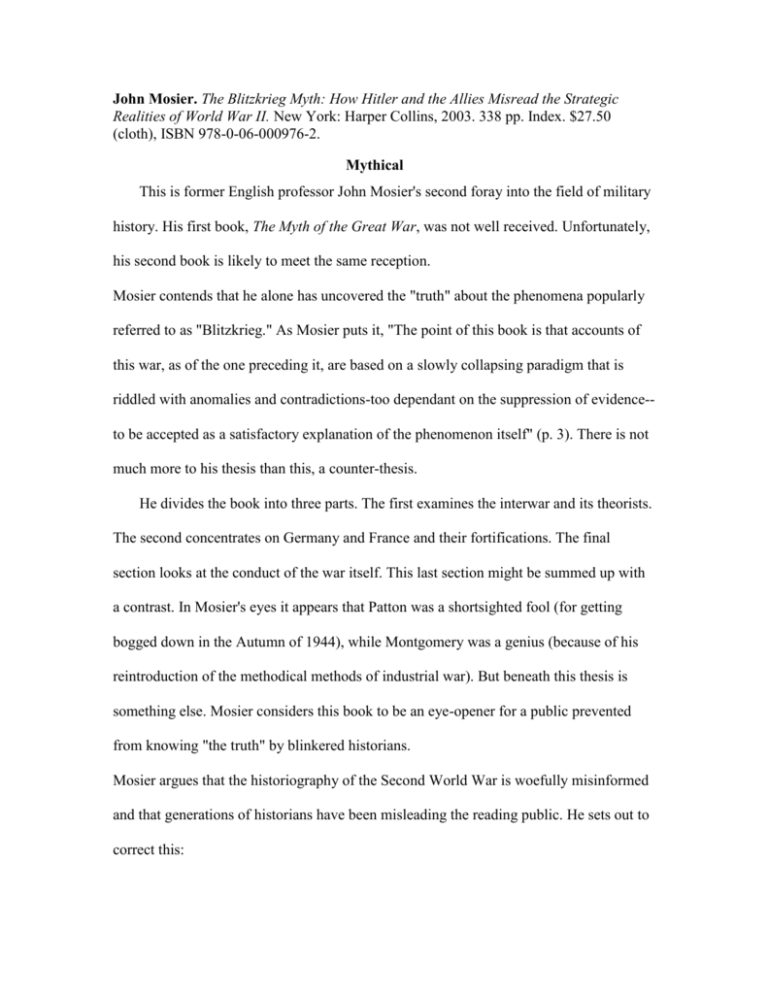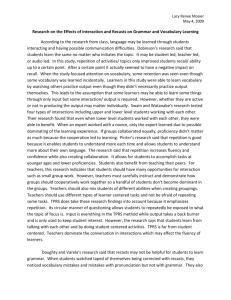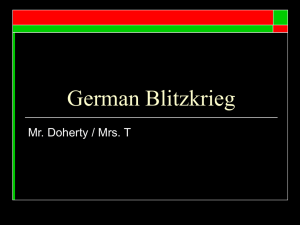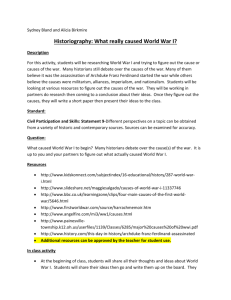John Mosier
advertisement

John Mosier. The Blitzkrieg Myth: How Hitler and the Allies Misread the Strategic Realities of World War II. New York: Harper Collins, 2003. 338 pp. Index. $27.50 (cloth), ISBN 978-0-06-000976-2. Mythical This is former English professor John Mosier's second foray into the field of military history. His first book, The Myth of the Great War, was not well received. Unfortunately, his second book is likely to meet the same reception. Mosier contends that he alone has uncovered the "truth" about the phenomena popularly referred to as "Blitzkrieg." As Mosier puts it, "The point of this book is that accounts of this war, as of the one preceding it, are based on a slowly collapsing paradigm that is riddled with anomalies and contradictions-too dependant on the suppression of evidence-to be accepted as a satisfactory explanation of the phenomenon itself" (p. 3). There is not much more to his thesis than this, a counter-thesis. He divides the book into three parts. The first examines the interwar and its theorists. The second concentrates on Germany and France and their fortifications. The final section looks at the conduct of the war itself. This last section might be summed up with a contrast. In Mosier's eyes it appears that Patton was a shortsighted fool (for getting bogged down in the Autumn of 1944), while Montgomery was a genius (because of his reintroduction of the methodical methods of industrial war). But beneath this thesis is something else. Mosier considers this book to be an eye-opener for a public prevented from knowing "the truth" by blinkered historians. Mosier argues that the historiography of the Second World War is woefully misinformed and that generations of historians have been misleading the reading public. He sets out to correct this: "This book, the result of a quarter century of research and reflection, demonstrates that traditional accounts of the Second World War are seriously flawed. The fundamental error is this: in the 1920s most notably English armored officer J.F.C. Fuller and the Italian aviator Giulio Douhet postulated two new theories of warfare. Over the course of the next decades these theories--or their key portions--were adopted almost universally by military and political leaders and by historians and military analysts" (p. 1). According to Mosier, historians have misled the public in matters large and small. They have misled on German doctrine: "The German case is particularly relevant, since it is commonly believed that it was in the German army that these new doctrines of mechanized warfare, which were by and large Fuller's doctrines, first bore fruit" (p. 29). They have misled on French doctrine, strategy, and economics: "Second, it is usually thought that the money spent on fortifications by France was directly responsible for its lack of tanks and planes in 1940s" (p. 43) and, "What is still not realized by most analysts is the quantity of tanks the French had on hand at the start of the fighting" (p. 54). They have misled on matters as small as landmines: "German defenses relied on a new and disturbing principle, the buried mine," a weapon, which Mosier says, has "apparently" escaped the notice of historians (p. 42). Mosier's fundamental point is that there was no such thing as Blitzkrieg, no "lightning war" that swept through France in 1940. The Germans did not have superior tanks, doctrine, or soldiers. In May 1940, Mosier argues, the French were the superior army. They had more and better tanks, and "a considerably more advanced understanding of what kinds of tanks would actually be successful on the battlefield" (p. 56). Why then was France lost in 1940? Panic, Mosier argues. Panic on the part of the French government, and an enablement of that panic by Winston Churchill. When Paul Reynaud called Churchill on the night of May 15 and stated that France had lost, Churchill, representing perfidious Albion, believed him: "So at this vital juncture, Churchill made a catastrophic misjudgment, all the more glaring because he should have been the most aware of the historical precedents of the French government being inclined to panic, and in the contrary precedent, of a country that historically had been willing to fight on regardless of what happened to that same government" (p. 142). Mosier offers other startling revelations: J. F. C. Fuller was full of himself; B. H. Liddell-Hart was a shameless self-promoter before and after the war; many of the German "Panzer-generals" puffed up their own reputations in their post-war memoirs; the interwar German Army actually did not develop a comprehensive concept for major rapid breakthrough wars before the war but instead developed one more-or- less on the fly; the Germans devoted some of their resources towards defensive works in that same interwar period. Historians of World War II may be somewhat surprised to read these startling "revelations" and "new" interpretations, as they may be under the impression that over the last 20 years a range of second world war scholars-such as R. H. S. Stolfi, Robert Citino, Geoff Megargee, James Corum and many others were undertaking similar and more deeply investigated interrogations of the Blitzkrieg legend, so much so that the "myth" that Mosier points to is one that few historians of the Second World still follow.[1] How then did Mosier believe that his argument is fundamentally revisionist? Simple: it seems that, charitably speaking, Mosier does not know the first thing about what has been written about the Second World War over roughly the last twenty to thirty years. To give an example of this, I checked two chapters for Mosier's sources. (He relied almost completely upon secondary sources for this work.) The average of the publication dates was 1975 for one chapter and 1974 for the other. He does not list in his sources works by the aforementioned scholars, nor by specialists such as Eugenia Kiesling, whose book Arming Against Hitler: France and the Limits of Military Planning (1996) when coupled with Robert Doughty's The Seeds of Disaster: The Development of French Army Doctrine, 1919-1939 (1985), normally serve as one of the first stops for any scholar examining the failure of the French in 1940.[2] Nor has Mosier seemingly heard of Geoffrey Megargee's magnificent work, Inside Hitler's High Command (2000), which indirectly does much the same for the opposite side of the lines.[3] Even when Mosier does engage with some of the critical historiography, his judgment is shaky, at best: Marc Bloch is readable but "unreliable," while David Irving is cited without caveat (for Bloch, see p. 299; for Irving, see fn. 1, pg. 209). Mosier had warning about how outdated his historiographical conception was, but missed the opportunity to save himself. Encountering Russell Stolfi's 1966 dissertation "far along in the writing of this book" Mosier realized that it "advanc[ed] a similar thesis" (p. 58). Rather than following up the lead, Mosier did nothing more than acknowledge that fact in a footnote, in the process completely missing Stolfi's Hitler's Panzers East, and the opportunity to investigate the modern historiography.[4] In an effort to help Professor Mosier catch up with the historiography, I can recommend authors who would be useful to start what would likely be a long reading list. Just off the top of my head, I recommend Doughty, Keisling, Bonn, Mansoor, Hart, Citino, and most especially Geoff Megargee.[5] I would also note that Mosier's publisher, Harper Collins, should learn that one needs more than an accusation of a myth to sell a new work of history. One actually needs evidence that there is a myth surrounding the topic. Mosier fails in that account. His book brings no new synthesis to the market of ideas, and I recommend against buying it. Bibliography Robert Bateman [1]. R. H. S. Stolfi, Hitler's Panzers East: World War II Reinterpreted (Norman: University of Oklahoma Press, 1991); Robert Michael Citino, The Path to Blitzkrieg: Doctrine and Training in the German Army, 1920-1939 (Boulder: Lynne Rienner Publishers, 1999); Robert Michael Citino, Quest for Decisive Victory: From Stalemate to Blitzkrieg in Europe, 1899-1940 (Lawrence: University Press of Kansas, 2002); Geoffrey P. Megargee, Inside Hitler's High Command (Lawrence: University Press of Kansas, 2000); James S. Corum, The Roots of Blitzkrieg: Hans Von Seeckt and German Military Reform (Lawrence: University Press of Kansas, 1992). [2]. Eugenia C. Kiesling, Arming against Hitler: France and the Limits of Military Planning (Lawrence: University Press of Kansas, 1996); Robert Doughty, The Seeds of Disaster: The Development of French Army Doctrine, 1919-1939 (Hamden: Archon Books, 1985); and also Doughty, The Breaking Point: Sedan and the Fall of France,1940 (Hamden: Archon Books, 1990). [3]. See note 1. [4]. R. H. S. Stolfi, "Reality and Myth: French and German Preparations for War, 19331940" (Ph.D. diss., Stanford University, 1966). [5]. See note 1; also see Keith E. Bonn, When the Odds Were Even: The Vosges Mountains Campaign, October 1944-January 1945 (Novato: Presidio, 1994); Peter R. Mansoor, The GI Offensive in Europe: The Triumph of American Infantry Divisions, 1941-1945 (Lawrence: University Press of Kansas, 1999); R. Hart, Clash of Arms: How the Allies Won in Normandy (Boulder: Lynne Rienner, 2001). Library of Congress Call Number: D743.M647 2003







